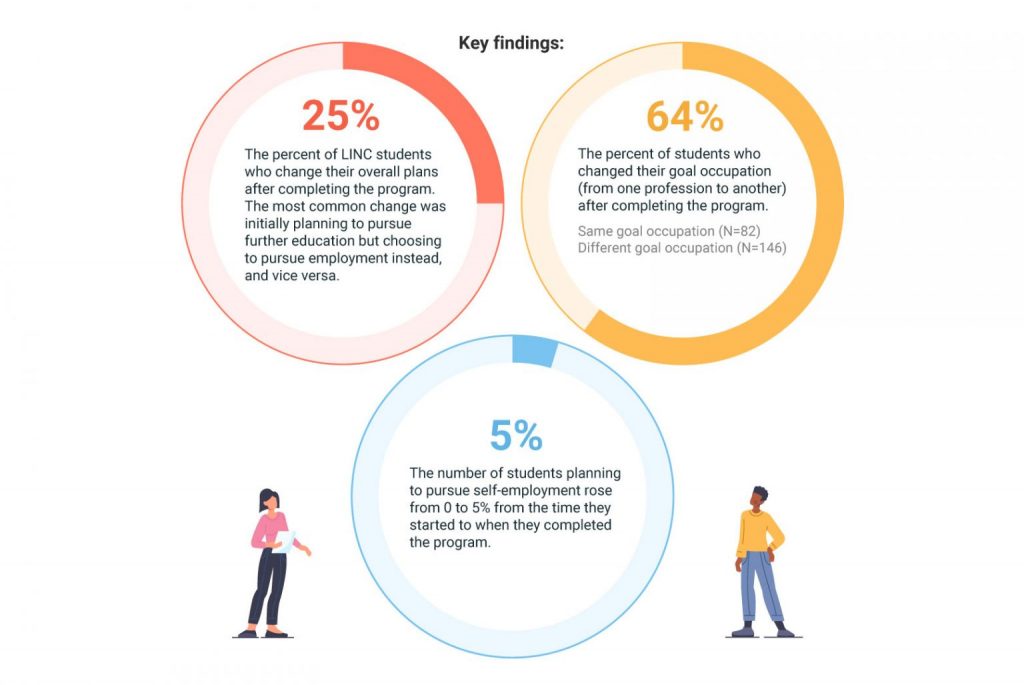Analysis of LINC Students’ Career Goals Pathways
Researchers: Lisa Rochman1, Erika Goble1, Maria Montenegro1, Marco Garcia Salinas1, Mesay Tegegne1, Timothy Anderson2, Anna M. Janik3, Brooke Leifso1, Shea Manweiler4, and Mary Malott4
Affiliation: NorQuest College1, MacEwan University2, and Red River College3 and Designers4
Research Partner: NorQuest College
Keywords: newcomers, settlement, employment, economic integration, Language Instruction for Newcomers to Canada (LINC), career goals changes, narrative inquiry, career pathways, knowledge mobilization, board game
Jump to: Full infographic, Methodology, Findings, Knowledge Mobilization, Publications & Reports
Summary
Overview: This study identified the most common career goal changes made by LINC students, the most common pathways for those who change their career goals, and how the LINC program and services influence career goal changes. Through the knowledge mobilization initiative of the board game, this study also increased collaboration and interest in collaborative research among LINC providers in order to improve support for newcomers’ career goals.
Objectives:
- To understand the common pathways of newcomers’ career goals as they progress through the Language Instruction for Newcomers to Canada (LINC) program that is offered by both NorQuest College and Red River College;
- To identify common pathways changes for newcomers as they progress through LINC and the settlement process; and
- To identify how the LINC program and other factors impact goal pathways.
Research Justification: Newcomers’ economic integration is impacted not only by their opportunities and barriers, but also by their career goals and how these change throughout the settlement process. Past research at NorQuest College showed that students’ career goals change from when they register for the LINC program to when they exit the program. These new career goals define the subsequent steps that LINC alumni take, ultimately influencing their economic outcomes. There is limited research, however, into the common career goal changes, what trajectories the changes take, and what factors influence the change process.
Infographic Excerpt

Methodology
The research team used an explanatory sequential mixed method approach for this project. Phase 1 involved a quantitative analysis of NorQuest College’s student records and the 2018-2019 LINC Outcome Survey to identify common goal changes. Phase 2 involved face-to-face narrative interviews with LINC students who had engaged in the most common pathway changes identified in Phase 1. The purpose of the narrative interviews was to understand how and why the students’ career goals changed. The interviews were then analysed using the Arthur Frank narrative inquiry approach to identify eight typologies of career goal pathway changes based on the meaning-making behind those goal changes.
Findings:
- 25% of all LINC students changed their overall plans post-LINC upon completion.
- The most common changes were those who initially planned to pursue further education choosing employment (36%); and those who thought to pursue employment opting for further education (25%).
- 64% changed their goal occupation (from one profession to another). The most common occupational change was from Health Professions to Education and Social Services (16%) and from Education and Social Services to Health Professions (13%).
- Self-employment became a viable post-program option for many career changers. Where none of the LINC students initially planned for self-employment, by the time they completed the program, 5% were pursuing self-employment.
- Eight typologies of career goal pathway changes were found in the narrative inquiry phase of the project. The types were labelled: "the Industrious Companion," "the Map Reader," "the Copyist," "the Escape Artist," "the Converted Volunteer," "the Analyst," "the Interrupted Pragmatist," and "the Sod-Layer". LINC students may initially embody one 'type' but, after a specific encounter, begin to embody a different 'type'. This points to the power of specific experiences either within the LINC program (e.g., a positive volunteering experience) or outside of it (e.g., discovering the length of time recertification of their credentials will take).
- The typologies also revealed that no single set of LINC program supports were adequate for all students. Rather, depending on the 'type' of career changer they embodied, each group would leverage different program and community supports.
- Both the quantitative and qualitative data suggests that LINC students may have clear career goals at the time of completion and a strong understanding of how to achieve them, but there is a significant gap between students’ current occupations (post-LINC completion) and occupational aspirations. This suggests that further support is needed to help LINC students achieve their career goals post-LINC.
Knowledge Mobilization Component
The researchers worked with artist Shea Manweiler to create a board game intended as a teaching resource for LINC providers and instructors to better support newcomers’ settlement processes. Game pieces represent LINC students, each governed by different rules determined by the career path typology identified in the study. The board game was presented to LINC providers alongside the narrative typologies developed in the first part of the study; due to COVID-19, the presentations and game play took place online. The research team is working to adapt the game for a wider audience and to create an online version.
Explore more projects


